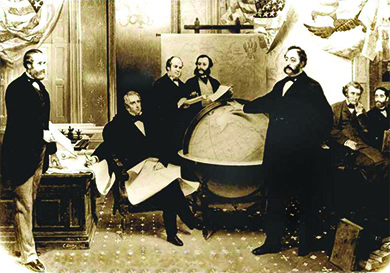| << Chapter < Page | Chapter >> Page > |
Most notably, in 1867, Seward obtained the Alaskan Territory from Russia for a purchase price of $7.2 million. Fearing future loss of the territory through military conflict, as well as desiring to create challenges for Great Britain (which they had fought in the Crimean War), Russia had happily accepted the American purchase offer. In the United States, several newspaper editors openly questioned the purchase and labeled it “ Seward’s Folly ” ( [link] ). They highlighted the lack of Americans to populate the vast region and lamented the challenges in attempting to govern the native peoples in that territory. Only if gold were to be found, the editors decried, would the secretive purchase be justified. That is exactly what happened. Seward’s purchase added an enormous territory to the country—nearly 600,000 square miles—and also gave the United States access to the rich mineral resources of the region, including the gold that trigged the Klondike Gold Rush at the close of the century. As was the case elsewhere in the American borderlands, Alaska’s industrial development wreaked havoc on the region’s indigenous and Russian cultures.

Seward’s successor as Secretary of State, Hamilton Fish, held the position from 1869 through 1877. Fish spent much of his time settling international disputes involving American interests, including claims that British assistance to the Confederates prolonged the Civil War for about two years. In these so-called Alabama claims, a U.S. senator charged that the Confederacy won a number of crucial battles with the help of one British cruiser and demanded $2 billion in British reparations. Alternatively, the United States would settle for the rights to Canada. A joint commission representing both countries eventually settled on a British payment of $15 million to the United States. In the negotiations, Fish also suggested adding the Dominican Republic as a territorial possession with a path towards statehood, as well as discussing the construction of a transoceanic canal with Columbia. Although neither negotiation ended in the desired result, they both expressed Fish’s intent to cautiously build an American empire without creating any unnecessary military entanglements in the wake of the Civil War.
While the United States slowly pushed outward and sought to absorb the borderlands (and the indigenous cultures that lived there), the country was also changing how it functioned. As a new industrial United States began to emerge in the 1870s, economic interests began to lead the country toward a more expansionist foreign policy. By forging new and stronger ties overseas, the United States would gain access to international markets for export, as well as better deals on the raw materials needed domestically. The concerns raised by the economic depression of the early 1890s further convinced business owners that they needed to tap into new markets, even at the risk of foreign entanglements.

Notification Switch
Would you like to follow the 'U.s. history' conversation and receive update notifications?